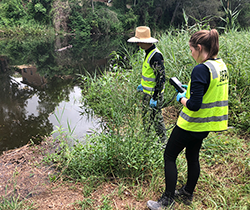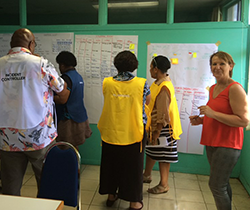Special EPA unit co-ordinates rapid response
The EPA’s Incident and Emergency Coordination Unit was established to effectively manage environmental incidents around NSW with a rapid response team and improved scientific sampling.

The EPA’s Incident and Emergency Coordination Unit (IECU) was established in direct response to the need to effectively manage environmental incidents around NSW with a rapid response team and improved sampling capability.
Acting IECU Head Dr Katelyn Edge told EPA Connect that the highly experienced team of eight plays a major support role for the EPA in responding to emergencies where the environment is at risk.
“This means we not only plan for, prepare and respond to incidents but we also provide effective support and investigation to minimise environmental harm and facilitate site restoration or clean-up of residues by the responsible party,” Dr Edge said.
“We are all on the 24/7 on-call roster and respond to any incidents notified by external agencies such as Fire and Rescue NSW or Port Authorities – this can involve anything and everything!
“We call upon our team’s technical and regulatory knowledge and skills and if the incident is significant, we go out on site to assist our EPA regional colleagues,” she said, adding “no day is the same.”
The Unit also relies on scientific expertise from the Environmental Sampling Analysis Team who collect samples from asbestos contaminated landfill, oil spills or gas from landfill.
From bushfire recovery and water-tank testing to pollution clean-up
Four IECU staff assisted the EPA’s North Branch in February with recovery operations, including waste management and environmental recovery, following the northern NSW bush fires at Tabulam and Tingha. This included checking damaged buildings for asbestos, testing drinking water polluted by fire-fighting foams and retardants and recommending the safe disposal of waste. The Unit remains responsible for co-ordinating waste management and environmental clean-up of the Bruxner Jennings bush fire near Tenterfield.
Other recent activities for the IECU include
- Environmental sampling and rapid response of coal ash sampling at Bayswater Power Station; Water Runoff at Hunter Valley Operations Coal mine; and Truck fire incident on Bulli Pass.
- Assisting Metro and North branches with sewage overflow incident management and investigation.
- Supporting an illegal dumping investigation in South Western Sydney.
- Participating in oil spill response training (see story on Oil fingerprinting in Pambula).
- Emergency pollution clean-up program of asbestos waste dumped in the Sydney CBD.
- Assessing council applications for EPA’s emergency pollution clean-up funds.
When asked about the team’s most interesting or challenging jobs over the past year, Dr Katelyn Edge cited “working with Public Works and Office of Emergency Management to resolve the issue of fire-retardant pollution in the Tingha community’s water tanks following the bushfire fighting in northern NSW. This is the first time this has been addressed with funding assigned to clean the tanks and replace with potable water.”
EPA’s Dianne Gordon delivers emergency training in Fiji

Dianne Gordon (far right) running emergency response training in Fiji.
Incident management expert, Dianne Gordon from the EPA’s Incident and Emergency Coordination Unit helped deliver emergency management training to 20 staff at the Fijian Ministry of Health in October last year.
Fiji’s Ministry of Health is focused on clinical care and public health and has significant responsibility for environmental health and monitoring. The training program was funded by Australia’s Department of Foreign Affairs and Trade and was customised for the needs of Fijian emergency management workers, as Fiji regularly experiences disasters such as cyclones and earthquakes.
The three-day training course included a full-day simulation exercise facilitated by Dianne.
“It was great to see the group innovate as they worked,” Ms Gordon said
“If a natural disaster hits Fiji, it’s highly likely there would be little infrastructure left. The group worked through this issue and came up with some great solutions.”

